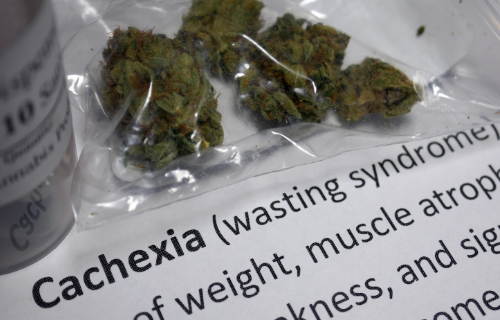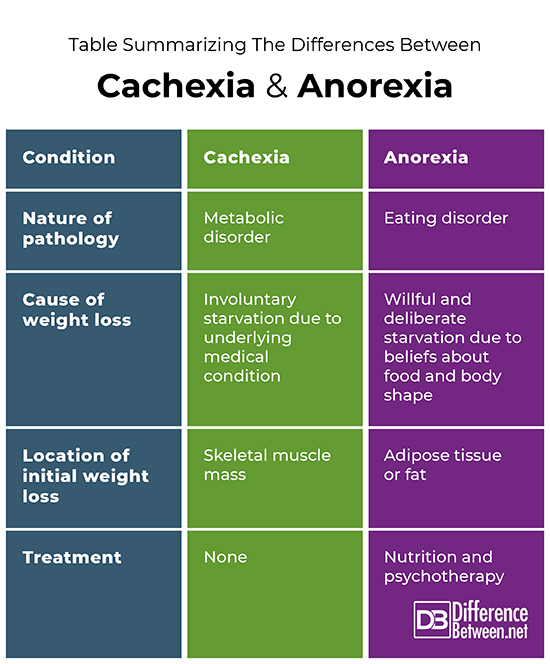Difference Between Cachexia and Anorexia
Cachexia and anorexia are both wasting diseases characterized by weight loss and anemia, and anorexia, meaning of loss of appetite, is a criterion for diagnosing cachexia. However, cachexia and anorexia are two distinct conditions in terms of their classification, the degree of choice involved in the weight loss, the location of the wasting, and the prognosis or outcome.

What is Cachexia?
Cachexia is the irreversible wasting away of the body that occurs during the last stages of severe chronic illnesses such as cancer, HIV/AIDS, chronic renal failure, multiple sclerosis, Crohn’s disease and congestive heart failure (Stephan von Haehling and Anker).
D. Brooke Widner et al. describe the condition as multifaceted and characterized by progressive weight loss due to the depletion of skeletal muscle mass due to an increase in protein degradation and decrease in protein synthesis. Systemic inflammation has been implicated for its role in the development of the cachexia, but many questions remain about the molecular mechanisms thought to play a role in its development. In the end, cachexia leads to functional impairment and death.

What is Anorexia?
Anorexia is classified as a psychiatric disorder in which a person willfully and deliberately refuses to maintain a minimally normal body weight and relentlessly pursues thinness to the point of starvation. While hunger is frequently present, the pathological control of this instinct is a source of satisfaction for the person suffering from anorexia. The characteristics of anorexia include intense fears of gaining weight and a distorted body image. Anorexics will commonly see themselves as overweight, although they are in fact underweight.
At some point in their lives, 0.9% to 4.3% of women and 0.2% to 0.3% of men in Western countries will suffer from anorexia. The onset most often occurs in adolescence (Benjamin Saddock and Saddock). Explanations for its onset include a genetic predisposition, difficulties transitioning from girlhood to womanhood, difficulties maintaining autonomy, socio-cultural and environmental factors, and the stress induced by major life-changes or events. Depression (65 percent of cases), social phobia (34 percent) and obsessive-compulsive disorder (26 percent) are often present. Associated medical complications may include osteoporosis, infertility, and heart damage (N. B. Kumar et al.).
The outcome varies from spontaneous recovery to intermittent episodes throughout the sufferer’s life to death from starvation. Of all psychological disorders, it has the highest mortality rate. In 2013, it directly resulted in about 600 deaths globally, up from 400 deaths in 1990 (C. J. Murry et al.).
Treatment of anorexia involves restoring a healthy weight, treating the underlying psychological issues, and addressing behaviors that promote the disorder. Both cognitive behavioral and Maudsley family therapies have been shown to be effective. Half of all women with anorexia achieve full recovery, while an additional 20–30% partially recover. Some 20% develop anorexia nervosa as a chronic disorder.
Difference between Cachexia and Anorexia
- First, cachexia is a metabolic disorder associated with an underlying medical condition; in contrast, anorexia is classified as a psychiatric and eating disorder.
- Second, in cachexia, weight loss is involuntary, the outcome of an underlying medical condition, for example, cancer; in anorexia, the weight loss is willful and deliberate.
- Third, weight loss from inadequate caloric intake among anorexics causes fat loss before muscle loss, whereas initial skeletal muscle loss is a key feature in cachexia.
- Unlike anorexia, nutrition treatments cannot reverse cachexia. Changes in diet and an increase in nutrient intake do not consistently result in weight gain and increased muscle function. However, although weight loss can be stabilized with calorie-dense protein supplements so that the underlying condition can be treated (N. B. Kumar et al.)
Table summarizing the differences between cachexia and anorexia

Summary
While cachexia and anorexia share similarities, for example, they are wasting diseases associated with anemia, they differ in terms of their classification (medical versus psychiatric condition), degree of choice involved in the weight loss (involuntary versus intentional), initial location of wasting (skeletal muscle mass versus fat tissue), and prognosis (recovery versus death).
FAQ:
How do you identify cachexia?
The primary features of cachexia include the pale and wasted appearance of a patient due to progressive depletion of skeletal muscle mass; reduced food intake; abnormal metabolism of carbohydrate, protein, and fat; reduced quality of life; and increased physical impairment.
Is cachexia the same as starvation?
If starvation is defined as death caused by lack of food, the presence of anorexia or loss of appetite suggests cachexia can be considered involuntary starvation due to a metabolic dysfunction. Studies using a calorie-dense protein supplementation suggest weight stabilization can be achieved, but improvements in lean body mass have not been observed (N. B. Kumar et al.)
What are the stages of cachexia?
K. C. Fearon et al. classified the stages of cachexia based on international consensus. In Stage 1, patients with pre-cachexia have less than 5% premorbid bodyweight loss, but display signs of anorexia and/or metabolic changes. In Stage 2, patients show a weight loss greater than 5% of their premorbid bodyweight or the weight loss is greater than 2% with signs of skeletal muscle loss and a body mass index under 20. In this stage, patients are likely to have systemic inflammation. Cachexic patients in the final stage, refractory cachexia, have a life expectancy of less than three months, and their condition is no longer responsive to treatment.
Can you live with cachexia?
As muscle wasting progresses, patient fatigue and weakness grow. Daily activities become a constant struggle. In addition, cachexia makes it more difficult to treat the underlying condition because, for example, in cancer, chemotherapy treatments are too toxic to endure and major surgeries too high a risk. No definitive treatment or cure for cachexia exists although the condition can be stabilized with calorie-dense protein supplements so that the underlying illness can be treated.
- Difference Between Ecchymosis and Erythema - August 15, 2022
- Difference Between Autobiographical Memory and Episodic Memory - August 1, 2022
- Difference Between Biological Drive and Social Motive - July 30, 2022
Search DifferenceBetween.net :
Leave a Response
References :
[0]Fearon K., et al. "Definition and classification of cancer cachexia: an international consensus." The Lancet Oncology, vol. 12, no. 5, May 2011, pp. 489–95. doi:10.1016/s1470-2045(10)70218-7
[1]Kumar N.B., et al. "Cancer cachexia: traditional therapies and novel molecular mechanism-based approaches to treatment." Current Treatment Options in Oncology, vol 11, no. 3–4, December 2010, pp. 107–17. doi:10.1007/s11864-010-0127-z
[2]Mueller T. C., et al. "Molecular pathways leading to loss of skeletal muscle mass in cancer cachexia–can findings from animal models be translated to humans?" BMC Cancer, vol. 16, no. 1, 2016, p. 75.
[3]Murray C.J., et al. "Global, regional, and national age-sex specific all-cause and cause-specific mortality for 240 causes of death, 1990-2013: a systematic analysis for the Global Burden of Disease Study 2013." Lancet, vol. 385, no. 9963, January 2015, pp. 117–71. doi:10.1016/S0140-6736(14)61682-2.
[4]Saddock, Benjamin James and Virginia Alcott Saddock. Kaplan and Saddock's Synopsis of Psychiatry, 9th edition, Lippincott Williams & Wilkins, 2003.
[5]Widner, D. Brooke, et al, Preclinical and clinical studies on cancer-associated cachexia. Frontiers in Biology, vol. 13, 2018, pp. 11–18
[6]von Haehling, S. and S. D. Anker. "Cachexia as a major underestimated and unmet medical need: facts and numbers." Journal of Cachexia, Sarcopenia and Muscle, vol. 1, no. 1, September 2010, pp. 1–5. doi:10.1007/s13539-010-0002-6.
